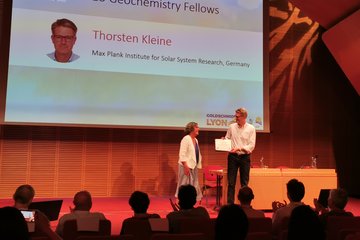Alle Typen
101.
Buchkapitel
Multipoint Analysis of Electric Currents in Geospace Using the Curlometer Technique. In: Electric Currents in Geospace and Beyond, Bd. 235, S. 67 - 80 (Hg. Keiling, A.; Marghitu, O.; Wheatland, M.). Wiley, Hoboken (2018)
102.
Buchkapitel
The Role of the Upper Atmosphere for Dawn-Dusk Differences in the Coupled Magnetosphere-Ionosphere-Thermosphere System. In: Dawn-Dusk Asymmetries in Planetary Plasma Environments, S. 125 - 141 (Hg. Haaland, S.; Runov, A.; Forsyth, C.). Wiley, Hoboken (2017)
103.
Buchkapitel
Dawn-Dusk Asymmetries at the Terrestrial Magnetopause: Observations. In: Dawn-Dusk Asymmetries in Planetary Plasma Environments, S. 73 - 84 (Hg. Haaland, S.; Runov, A.; Forsyth, C.). Wiley, Hoboken (2017)
104.
Buchkapitel
Magnetopause Thickness at the Dawn and Dusk Flanks. In: Dawn-Dusk Asymmetries in Planetary Plasma Environments, S. 85 - 93 (Hg. Haaland, S.; Runov, A.; Forsyth, C.). Wiley, Hoboken (2017)
105.
Buchkapitel
Dawn-Dusk Asymmetries in the Near-Earth Plasma Sheet: Ion Observations. In: Dawn-Dusk Asymmetries in Planetary Plasma Environments, S. 243 - 253 (Hg. Haaland, S.; Runov, A.; Forsyth, C.). American Geophysical Union, Washington (2017)
106.
Buchkapitel
Dawn-Dusk Asymmetries of Ionospheric Outflow. In: Dawn-Dusk Asymmetries in Planetary Plasma Environments, S. 273 - 284 (Hg. Haaland, S.; Runov, A.; Forsyth, C.). American Geophysical Union, Washington (2017)
107.
Buchkapitel
Low-energy Ion Outflow Observed by Cluster:Utilizing the Spacecraft Potential. In: Magnetosphere-Ionosphere Coupling in the Solar System, (Hg. Chappell, C. R.; Schunk, R. W.; Banks, P. M.; Burch, J. L.; Thorne, R. M.). Wiley Publishers, Hoboken, USA (2016)
108.
Buchkapitel
Mechanisms that produce auroral Asymmetries in conjugate hemispheres. In: Auroral Dynamics and Space Weather (Hg. Zhang, Y.; Paxton, L.). Wiley, Hoboken, USA (2016)
109.
Buchkapitel
Cold ion outflow as a source of plasma for the magnetosphere. In: Dynamics of the Earth's Radiation Belts and Inner Magnetosphere, S. 341 - 353 (Hg. Summers, D.; Mann, I. R.; Baker, D. N.; Schulz, M.). AGU, Washington, D.C. (2012)
110.
Buchkapitel
Plasma convection in the high-latitude ionosphere deduced from Cluster EDI data and the IMF Bx component. In: Physics of Auroral Phenomena, S. 43 - 46. Polar Geophysical Institute, Apatity, Russia (2011)
111.
Buchkapitel
Generation and Validation of Ion Energy Spectra Based on Cluster RAPID and CIS Measurements. In: The Cluster Active Archive, Studying the Earth's Space Plasma Environment, S. 301 - 306 (Hg. Laakso, H.; Taylor, M. G. T. T.; Escoubet, C. P.). Springer, Berlin (2010)
112.
Konferenzbeitrag
Ionospheric convection from C}luster {EDI} measurements: {C}omparison with the ground based {IZMEM ionospheric convection model. In: Physics of Auroral Phenomena, Proc. XXXII Annual Seminar, S. 59 - 62. Kola Science Centre, Russian Academy of Science, Apatity (2009)
113.
Vortrag
Prediction of soft protons in the near-Earth space using machine learning. ISSI team on “Soft protons in the magnetosphere focused by X-ray telescopes”, Bern, Switzerland (2019)
114.
Vortrag
IMF By control of plasma flow in the magnetosphere-ionosphere system: a multi-region superposed epoch analysis. 29th Cluster workshop, Lanzarote, Canary Islands, Spain (2019)
115.
Vortrag
The Direct Events Ion Product on RAPID. 29th Cluster workshop, Lanzarote, Canary Islands, Spain (2019)
116.
Vortrag
Heavy ions in the terrestrial magnetosphere: Cluster RAPID observations. 29th Cluster workshop, Lanzarote, Canary Islands, Spain (2019)
117.
Vortrag
Observations of Asymmetric Lobe Convection for Weak and Strong Tail Reconnection. 29th Cluster workshop, Lanzarote, Canary Islands, Spain (2019)
118.
Vortrag
The RAPID Direct Events product: what it is and how to use it. 24th Cluster Cross-Calibration Workshop, Maspalomas, Gran Canaria, Spain (2018)
119.
Vortrag
Response of Earth's neutral sheet to reversals in the IMF By Component. 5th Cluster-Themis Workshop, Chania, Greece (2018)
120.
Vortrag
The flank magnetopause: THEMIS and Cluster observations. 5th Cluster-Themis Workshop, Chania, Greece (2018)











